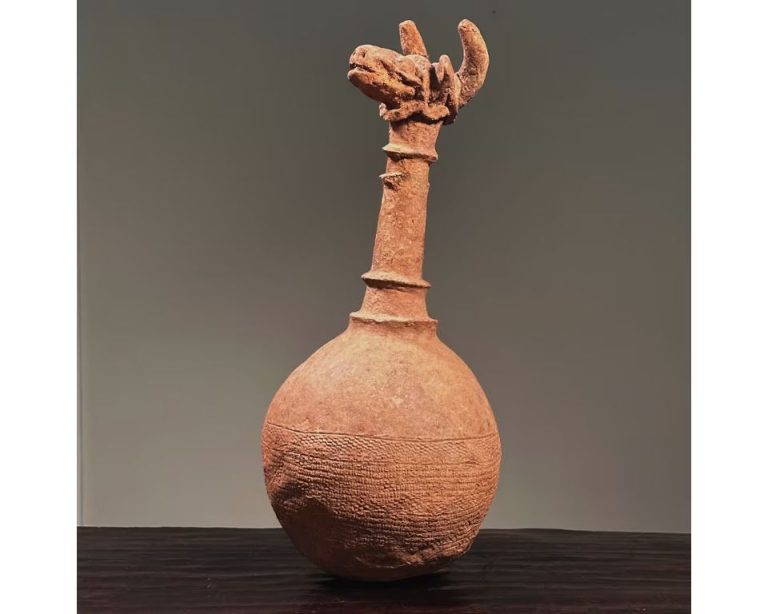What Makes Red Soil Red?
Red soil, also known as laterite soil or Terra Rossa, gets its distinct red color from the presence of iron oxides. This type of soil is found in tropical and subtropical regions across the world, often overlaying sedimentary rocks. Red soils are an important agricultural resource, valued for their fertility and ability to hold nutrients. Though found across the globe, some of the most extensive deposits of red soils are located in India, Africa, and Australia. The unique properties of these soils play a key role in shaping the landscapes and agricultural economies of many countries.
Iron Oxides
Iron oxides give red soil its distinct color. There are different types of iron oxides that contribute to the red hues found in soils around the world. The most common iron oxides are hematite and goethite.
Hematite is an iron oxide with the chemical formula Fe2O3. It appears red or reddish brown. Hematite forms when iron rich minerals are weathered and oxidized in humid, warm climates. The oxidized iron gives hematite its red pigmentation.
Goethite is an iron hydroxide with the chemical formula α-FeO(OH). It appears yellowish brown to red. Goethite forms through the weathering of iron rich minerals, especially in climates with abundant rainfall and drainage. The oxidized iron in goethite contributes to red soils’ coloration.
In addition to hematite and goethite, other iron oxides like maghemite (Fe2O3) can also influence the red hues in soil. The high iron oxide content gives red soils their distinctive reddish color that can range from red to yellowish brown to deeper brick red tones.
Weathering of Rocks
The weathering of parent rock materials is one of the key reasons that red soils contain high amounts of iron oxides. Rocks like basalt and granite contain iron minerals. Over long periods of time, these rocks weather due to mechanical and chemical breakdown. Mechanical weathering physically breaks down rocks through processes like freezing/thawing, abrasion, and pressure release. Chemical weathering transforms rocks through chemical reactions with substances like water, oxygen, and carbon dioxide.
As rocks like basalt weather, they release iron that can then oxidize into iron oxides which give red soil its distinctive color. The climate impacts the rate of weathering and the accumulation of iron oxides. In wet tropical areas with abundant rainfall and high temperatures, chemical weathering is rapid and iron oxides can accumulate quickly. Drier climates see slower rates of weathering and iron oxide buildup. Overall, the weathering of iron-rich parent material like basalt is a key process leading to the development of red-hued soils in many regions.
Drainage
Red soils tend to be well-drained, which is an important factor in how the iron oxides are formed. Good drainage allows oxygen to penetrate into the soil. When iron minerals come into contact with oxygen, they oxidize and turn red in color. Poorly drained soils limit oxygen exposure, so iron minerals remain in their reduced gray or green state. The open structure and granular nature of red soils creates pores and allows water to percolate through readily. This aerates the soil and provides the oxygen needed for oxidization. Red soils are thus characterized by good drainage, in contrast to more compacted clay soils that lack oxygen penetration. The aeration enabled by drainage is key to the development of the vivid red color.
Acidity
Red soils tend to be acidic, with pH levels generally between 4.5 and 6.5. This acidity is caused by several factors: the leaching of basic cations like calcium and magnesium by rainfall; the breakdown of organic matter which produces organic acids; and the oxidation of iron minerals which releases hydrogen ions. The low pH environment helps to stabilize iron oxides and keeps the iron in the oxidized Fe3+ form which gives the soil its red hue. If the pH rises, these iron oxides can break down and the soil loses its red coloration. The high acidity also has important impacts on crop growth and which species can thrive in red soils. It can increase the availability of some micronutrients like iron and manganese, but also causes toxicity of aluminum if levels get too high. Adding lime to increase pH is often necessary to reach the optimal range for most agricultural crops.
Organic Matter
Soil color is also influenced by the amount of organic matter present. Organic matter like decomposed leaves, plants, or animals can darken soil color. Most red soils have very little organic content, usually less than 1%, allowing the red color from iron oxides to show through. In areas with more vegetation and organic debris covering the surface, the red hue of the soil is obscured and muted into browner or blacker shades. However, if you dig past the organic layer, the distinctive red subsurface layers will be revealed.
The relative lack of organic matter in red soils makes sense when considering their typical environmental origins. Red soils tend to form in drier areas with sparse vegetation and little decomposition of plant or animal material. The hot, often tropical conditions speed up weathering of the iron-rich parent material into oxides, while slow decomposition fails to concentrate much organic content. This combination allows the iron-rich signature to dominate the soil color with little darkening from carbon-rich organic matter.
Uses
Red soils are highly valued for their agricultural uses, particularly for growing certain crops. The natural properties of red soils make them well-suited to producing some of the world’s most popular foods and beverages.
One of the most common agricultural uses of red soils is for coffee production. The tropical regions where red soils are found, such as Africa, Southeast Asia, and Central America, overlap with prime coffee-growing regions. Red soils provide good drainage and aeration for coffee plant roots, as well as retaining enough moisture and nutrients to support the plants. Many renowned coffee-growing regions, like the Kona district of Hawaii, are located in red soil areas.
Vineyards around the world also utilize red soils for grape cultivation. The excellent drainage helps prevent fungal root diseases, while the relatively low fertility stresses vines mildly and enhances wine grape quality. Famous wine regions with red soils include large parts of Bordeaux, Burgundy, Rioja, Tuscany, and Napa Valley.
In addition to coffee and wine grapes, red soils are good for growing fruits like berries and citrus, vegetables like tomatoes and peppers, and unique crops like tea, cocoa, and spices. The properties of red soils lend themselves well to specialty agriculture and integrated pest management techniques.
Distribution
Red soil is found predominantly in the tropics and subtropics. The major regions where it occurs are:
- Throughout Africa’s intertropical regions
- In India, especially in the Deccan Plateau region
- In South America, particularly in Brazil and parts of Argentina
- In tropical and subtropical regions of Australia, especially in the north and northwest
- In warmer parts of the southern United States
Red soils occur in both lowlands and uplands in these regions, usually in areas with pronounced dry and rainy seasons. The distinctive color develops in warm, humid environments through an interplay of climate, vegetation, parent material, topography, and soil age.
Threats
Red soils face several threats that degrade the soil and reduce productivity.
Erosion
Erosion from wind and water can strip away the topsoil layer of red soils. The fine particles are easily detached and transported away, lowering soil depth and exposing subsurface soil layers. Erosion removes the most fertile part of the soil, rich in organic matter and nutrients.
Overgrazing
Overgrazing of rangelands leads to loss of protective vegetation cover on red soils. The exposed soil is more prone to erosion from rainfall impact as well as wind. Trampling by livestock compacts the soil, reduces infiltration, and increases runoff and erosion.
Loss of Nutrients
The warm, moist, tropical climates where red soils occur lead to rapid breakdown of organic matter and leaching of nutrients. Red soils are naturally low in organic matter and nutrients due to this high rate of decomposition. Erosion and intensive cultivation deplete nutrients even further. Proper fertilization and organic matter additions are needed to maintain fertility.
Conclusion
In summary, red soils get their distinct color from the presence of iron oxides. These soils are formed over long timescales by the weathering of rocks in hot, wet, tropical environments. Good drainage as well as interactions with organic matter also contribute to the development of red soils. While nutrient-rich, red soils can be threatened by erosion, overfarming, and pollution. Preserving these soils is important, as they sustain agriculture and ecosystems in many regions globally. Their unique properties make red soils an intriguing facet of our landscape.


